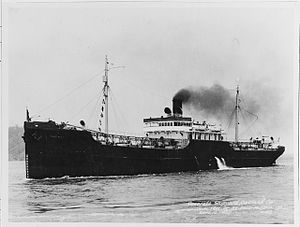Palo Alto (tanker)

Palo Alto on sea trials, on 10 September 1920.
(Naval History and Heritage Command - Photo NH 799) |
|
| History | |
|---|---|
|
|
|
| Name: | SS Palo Alto |
| Namesake: | Palo Alto, California |
| Builder: | San Francisco Shipbuilding Company, Oakland, California |
| Launched: | 29 May 1919 |
| Fate: | Grounded as a fishing pier at Seacliff Beach in Aptos, California |
| General characteristics | |
| Type: | Design 1100 tanker |
| Tonnage: | |
| Length: | 420 ft (130 m) |
| Beam: | 54 ft (16 m) |
| Depth: | 35 ft (11 m) |
| Propulsion: |
|
SS Palo Alto was a concrete ship built as a tanker at the end of World War I. It was built by the San Francisco Shipbuilding Company at the U.S. Naval Shipyard in Oakland, California. It was launched on 29 May 1919, too late to see service in the war. Her sister ship was the SS Peralta.
It was mothballed in Oakland until 1929, when it was bought by the Seacliff Amusement Corporation and towed to Seacliff State Beach in Aptos, California. A pier was built leading to the ship in 1930, and it was sunk in a few feet in the water so that its keel rested on the bottom. There it was refitted as an amusement ship, with amenities including a dance floor, a swimming pool and a café.
The company went bankrupt two years later during the Great Depression, and the ship cracked at the midsection during a winter storm. The State of California purchased the ship, and it was stripped of her fittings and left as a fishing pier. It was a popular site for recreational fishing, but eventually it deteriorated to the point where it was unsafe for this purpose, and it was closed to the public in 1950. Following an attempt at restoration in the 1980s, it reopened for fishing for a few years, then closed again. The fishing pier opened to foot traffic once again in the summer of 2016, but later closed for repairs.
Nicknamed the "Cement Ship,"Palo Alto today remains at Seacliff Beach and serves as an artificial reef for marine life. Pelicans and other seabirds perch on the wreck,sea perch and other fish feed on algae that grows in the shelter of the wreck, and sea lions and other marine mammals visit the wreck to feed on the fish.
...
Wikipedia
